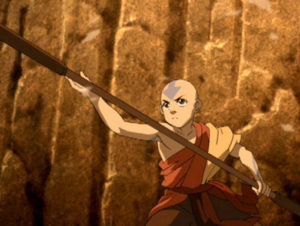While I love Star Wars: The Clone Wars and it’s probably my favorite animated series, I consider Avatar: The Last Airbender to be the best cartoon I’ve ever watched. Michael Dante DiMartino and Bryan Konietzko created a riveting world with a rich and broad tapestry. It’s so natural that I feel like I could go to the library and find a history of the World of Avatar in the non-fiction section. What really impresses me is that though there are history lesson episodes, most of the information about the world and its past is woven into the adventures of Aang and Team Avatar.
The world of Avatar: The Last Airbender is divided into four nations: the Fire Nation, the Air Nomads, the Earth Kingdom, and the Water Tribes. Over the years, each nation has formed a distinct culture. Different types of benders, people who can control the element of their nation – i.e. Fire Benders, populate the world. Not everyone is a bender, and only one person in the entire world can bend all four elements: the Avatar.
Pretty awesome, huh?
Just the history of the different versions of the Avatar is more than enough to fill the three seasons of the series. The existing Avatar can communicate with past incarnations of him/herself, and you learn about past events through that connection. It’s completely fascinating.
When you have that strong foundation, it helps the rest of the story fall into place, and Avatar works from the ground up. You follow the journey of Aang as he learns to hone his bending skills so he can face off against the powerful Fire Lord Ozai. The four nations used to live in peace, but the Fire Nation assumed control and have been ruling with a heavy hand. Aang is joined by several friends and allies along the way, including brother and sister Katara and Sokka.
There are plenty of moments of humor and antics and though there is the occasional gag for kids (like a fart joke), it resonates for adults, too. As Aang struggles to level up in time to take down Ozai, he has to conquer some heavy internal struggles. At the end of the day, he’s a 12-year-old kid who is responsible for saving the world. And you thought you had weight on your shoulders.
Because he’s the Avatar, citizens look to Aang to help them and to provide advice. He has to make difficult decisions along the way. Aang freaks out more than once, and I appreciate that they didn’t shy away from showing it in the cartoon. Very few preteens would be able to go what he went through with confidence and aplomb.
And even though kids watching the series can’t relate to the specifics of what Aang is dealing with, they can learn from the series. They see that it’s completely okay to be nervous about challenges, but that you have to head out with your chin high and face them anyway. They see that fights with your closest friends are going to happen, but that with work and understanding, you can repair the damages. They see that good and evil aren’t black and white and that someone who perhaps hasn’t made the best choices can redeem himself. Yeah, there are a few lessons, and actually, adults should pay attention to them as well.
If you check it out – and I highly recommend doing so – and you can’t get enough of Aang’s story, Dark Horse Comics has a wonderful line of comics that take place in the same universe with the same characters. You also may have heard of the live-action adaptation. Do yourself a favor and stay away from that movie; it will make you cry.


Comments are closed.